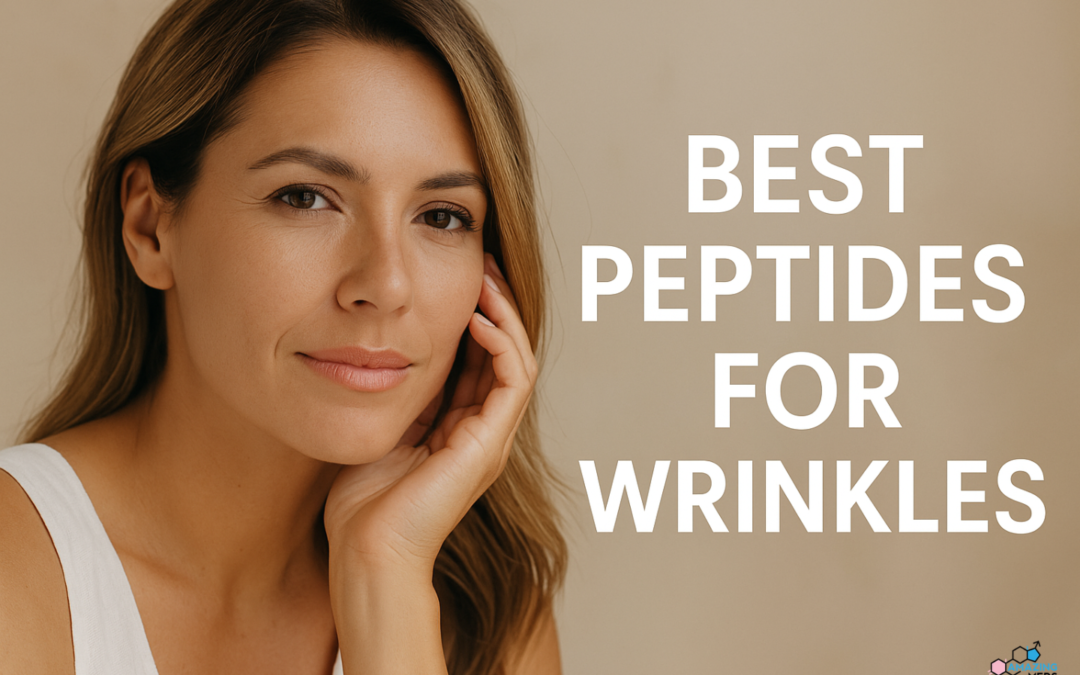As we age, collagen breaks down, elastin fibers become less elastic, and skin loses its firmness. The visible result is often fine lines, wrinkles, and sagging. While topical products and lifestyle changes can help slow these effects, peptides offer a deeper, more targeted solution.
Backed by clinical research, certain peptides can help restore skin structure, reduce wrinkles, and improve elasticity from the inside out. On this page, we’ll cover six of the most scientifically supported peptides for reducing wrinkles and fine lines.
What are peptides and why do they work?
Peptides are short chains of amino acids. In the body, they act as signaling molecules, triggering cells to carry out specific functions. When it comes to the skin, certain peptides can tell your body to produce more collagen, heal damaged tissue, or even relax facial muscles that cause expression lines.
Unlike traditional skincare products that sit on the surface, peptide therapy works beneath the surface to support long-term skin health.
Let’s explore the six best peptides for improving skin texture and reducing the appearance of fine lines and wrinkles.
1. GHK-Cu (Copper peptide)
GHK-Cu, also known as copper tripeptide-1 or GHK-Cu acetate, is one of the most researched peptides in the context of skin aging. First discovered in human plasma, GHK-Cu is naturally present in the body but declines with age.
How it works:
GHK-Cu promotes the production of collagen and glycosaminoglycans, both essential for maintaining firm, hydrated skin. It also enhances the activity of antioxidant enzymes, helping to protect skin cells from damage. Clinical studies show that GHK-Cu improves skin elasticity, reduces fine lines, and enhances wound healing.
Backed by science:
- A study published in International Journal of Molecular Sciences found that GHK-Cu increased collagen synthesis and improved dermal fibroblast function.
- Other research has shown it can tighten loose skin and improve clarity, thickness, and smoothness.
How Amazing Meds uses it:
At Amazing Meds, we provide GHK-Cu as part of customized anti-aging peptide therapy programs, tailored to your specific skin needs and overall health profile. Learn more here: https://amazing-meds.com/shop/product/ghk-cu-acetate/
2. Matrixyl (Palmitoyl pentapeptide)
Matrixyl is a well-known cosmetic peptide composed of five amino acids attached to a fatty acid. It helps rebuild the skin from the inside by promoting collagen and fibronectin production.
How it works:
Matrixyl binds to cell receptors and signals the skin to increase collagen synthesis. This results in a measurable reduction in wrinkle depth and improved skin texture over time.
Backed by science:
Clinical studies have shown that Matrixyl can reduce wrinkle depth by up to 30% after consistent use. It also boosts skin thickness and elasticity.
Best use case:
Matrixyl is commonly found in advanced cosmeceutical formulations, but when used as part of a compounded topical or injectable peptide protocol, it can deliver more pronounced effects.
3. Argireline (Acetyl hexapeptide-8)
Argireline is often referred to as a topical alternative to botulinum toxin because of its muscle-relaxing properties. It targets expression wrinkles, such as crow’s feet and forehead lines.
How it works:
This peptide inhibits the SNARE complex, which is involved in neurotransmitter release. As a result, it reduces the strength of facial muscle contractions that contribute to wrinkle formation.
Backed by science:
A study published in International Journal of Cosmetic Science found that Argireline reduced wrinkle depth by up to 17% in just 15 days.
Clinical application:
Amazing Meds incorporates Argireline into some compounded topical peptide formulas, especially for clients seeking non-invasive treatments for facial expression lines.
4. Acetyl tetrapeptide-5
Often used to reduce under-eye puffiness and improve skin tone, Acetyl tetrapeptide-5 also has a role in preventing collagen degradation and improving elasticity.
How it works:
This peptide helps minimize water retention and inflammation in the skin while improving firmness. It also reduces glycation, a process that stiffens collagen and leads to aging.
Backed by science:
Research shows it can significantly reduce eye bag volume and improve skin smoothness, making it ideal for delicate areas where wrinkles form early.
How it’s used:
It’s most effective when applied topically as part of a targeted under-eye or full-face peptide serum.
5. Tripeptide-1
Also known as palmitoyl tripeptide-1, this peptide is structurally similar to a fragment of collagen. It stimulates skin repair and renewal by promoting collagen and extracellular matrix production.
How it works:
Tripeptide-1 mimics the body’s own skin repair signaling. When applied regularly, it helps reduce fine lines and support skin density.
Backed by science:
One study demonstrated that tripeptide-1 used in combination with Matrixyl significantly improved skin tone and firmness in just four weeks.
Best application:
This peptide works well when combined with other collagen-boosting peptides in both topical and injectable formulations.
6. SNAP-8 (Acetyl octapeptide-3)
SNAP-8 is a more advanced version of Argireline, designed to reduce expression lines more effectively. It also inhibits muscle contraction but offers improved stability and longer-lasting results.
How it works:
It targets the same SNARE complex as Argireline but with increased efficacy, helping soften dynamic wrinkles caused by repeated facial expressions.
Backed by science:
In clinical settings, SNAP-8 has shown up to a 34% reduction in wrinkle depth after 28 days of use.
Professional use:
SNAP-8 is often compounded into topical therapies or used in conjunction with microneedling for enhanced penetration.
Why personalized peptide therapy matters
Off-the-shelf skincare can offer short-term improvements. But for long-term skin rejuvenation, personalized therapy is critical. At Amazing Meds, every peptide protocol is custom-compounded based on your skin type, age, hormone levels, and treatment goals.
Our team works with patients across the United States to develop targeted peptide and hormone therapy regimens that address the root causes of aging, including collagen breakdown, oxidative stress, and hormone imbalances.
We also provide telehealth support, lab testing, and ongoing medical guidance to help ensure your treatment is safe, effective, and optimized.
Start reversing the signs of aging today
If you’ve tried every over-the-counter serum and are still seeing wrinkles form, it may be time to take a more scientific and targeted approach. The peptides above are clinically validated and available as part of advanced therapy programs that go far beyond standard skincare.
At Amazing Meds, our licensed providers can help you access custom-compounded peptides and complementary therapies like bioidentical hormone replacement, HGH optimization, and GLP-1 support to help you look and feel younger from the inside out.
Frequently Asked Questions
What is the best peptide for reducing wrinkles?
The best peptide for reducing wrinkles is GHK-Cu (Copper peptide). It has been widely studied for its ability to stimulate collagen production, improve skin elasticity, and support tissue repair. GHK-Cu also offers antioxidant and anti-inflammatory benefits, making it especially effective for aging and damaged skin. Many patients experience firmer, smoother skin with consistent use.
Clinics like Amazing Meds offer GHK-Cu in customized therapeutic formulations that target deeper skin layers more effectively than standard over-the-counter products. Learn more here: https://amazing-meds.com/shop/product/ghk-cu-acetate/
Are peptides better than retinol for wrinkles?
Peptides and retinol work differently, and one is not necessarily better than the other. Retinol speeds up skin cell turnover and can help reduce fine lines, but it often causes irritation or dryness. Peptides, especially those like GHK-Cu or Matrixyl, help rebuild collagen and support long-term skin structure without harsh side effects. Many people benefit from using both in a well-rounded skin care protocol.
How long does it take for peptides to reduce wrinkles?
Most people start seeing visible results from peptide therapy within 4 to 12 weeks, depending on the peptide used, dosage, delivery method, and individual skin condition. For example, clinical studies on Matrixyl show a reduction in wrinkle depth after 4 weeks of consistent use. GHK-Cu may show improvements in skin texture and firmness in as little as 6 weeks.
Can peptides be combined with other anti-aging treatments?
Yes, peptides can be safely combined with other anti-aging treatments, including topical serums, microneedling, hormone replacement therapy, and even injectables like Botox. In fact, combining peptides with procedures that enhance skin penetration, such as microneedling, can increase their effectiveness.
What’s the difference between cosmetic peptides and medical-grade peptides?
Cosmetic peptides are typically found in over-the-counter skincare products and are often used in lower concentrations. While they can be helpful, their effects may be limited due to poor skin penetration or unstable formulas. Medical-grade peptides, on the other hand, are prescribed and compounded under physician supervision. These peptides are often stronger, more bioavailable, and specifically formulated for deeper skin rejuvenation.
Are peptide therapies safe for long-term use?
Peptide therapies are generally safe for long-term use when supervised by a licensed medical provider. Most peptides used for skin rejuvenation, such as GHK-Cu, Matrixyl, and SNAP-8, are well tolerated and have been studied for safety over extended periods. However, dosage, delivery method, and individual response should always be monitored.
Do peptides really build collagen in aging skin?
Yes, several peptides have been clinically shown to stimulate collagen synthesis in aging skin. GHK-Cu and Tripeptide-1 are two examples with strong scientific backing. They work by signaling the body to activate fibroblasts, the cells responsible for collagen production. As a result, skin becomes firmer, smoother, and more elastic. Regular use of these peptides, especially in medical-grade formulations, can lead to noticeable improvements in skin structure and wrinkle reduction over time.
What is the most effective way to apply peptides for wrinkles?
The most effective application depends on the peptide and the desired results. Some peptides, like GHK-Cu, can be used topically in high-quality compounded serums, while others may be more effective when injected or delivered through microneedling.
Are there any side effects from using peptides for anti-aging?
Most anti-aging peptides are well tolerated with minimal side effects. In topical use, mild redness or tingling may occur initially. Injectable peptides, when administered correctly, may cause temporary bruising or irritation at the injection site. Adverse reactions are rare but can occur, especially when peptides are used without proper medical supervision.
How can I get started with peptide therapy for wrinkles?
To start peptide therapy for wrinkles, it’s best to consult with a clinic that specializes in medically supervised peptide protocols. At Amazing Meds, you can begin with a telehealth consultation, where a licensed provider will assess your skin, age-related concerns, and overall health.
Based on your profile, they’ll design a personalized peptide treatment plan using compounds like GHK-Cu. From there, your prescriptions are shipped directly to you, and your progress is monitored to ensure safe, effective results. You can also directly access pharmaceutical-grade peptides on Amazing Meds’ online store: https://amazing-meds.com/shop/
References
- https://pubmed.ncbi.nlm.nih.gov/3169264/
- https://pubmed.ncbi.nlm.nih.gov/18492182/
- https://pubmed.ncbi.nlm.nih.gov/18498523/
- https://pubmed.ncbi.nlm.nih.gov/23417317/
- https://www.mdpi.com/1422-0067/19/7/1987
- https://pmc.ncbi.nlm.nih.gov/articles/PMC9760069/
- https://pmc.ncbi.nlm.nih.gov/articles/PMC6073405/
- https://pmc.ncbi.nlm.nih.gov/articles/PMC11291098/
- https://pmc.ncbi.nlm.nih.gov/articles/PMC10988741/

